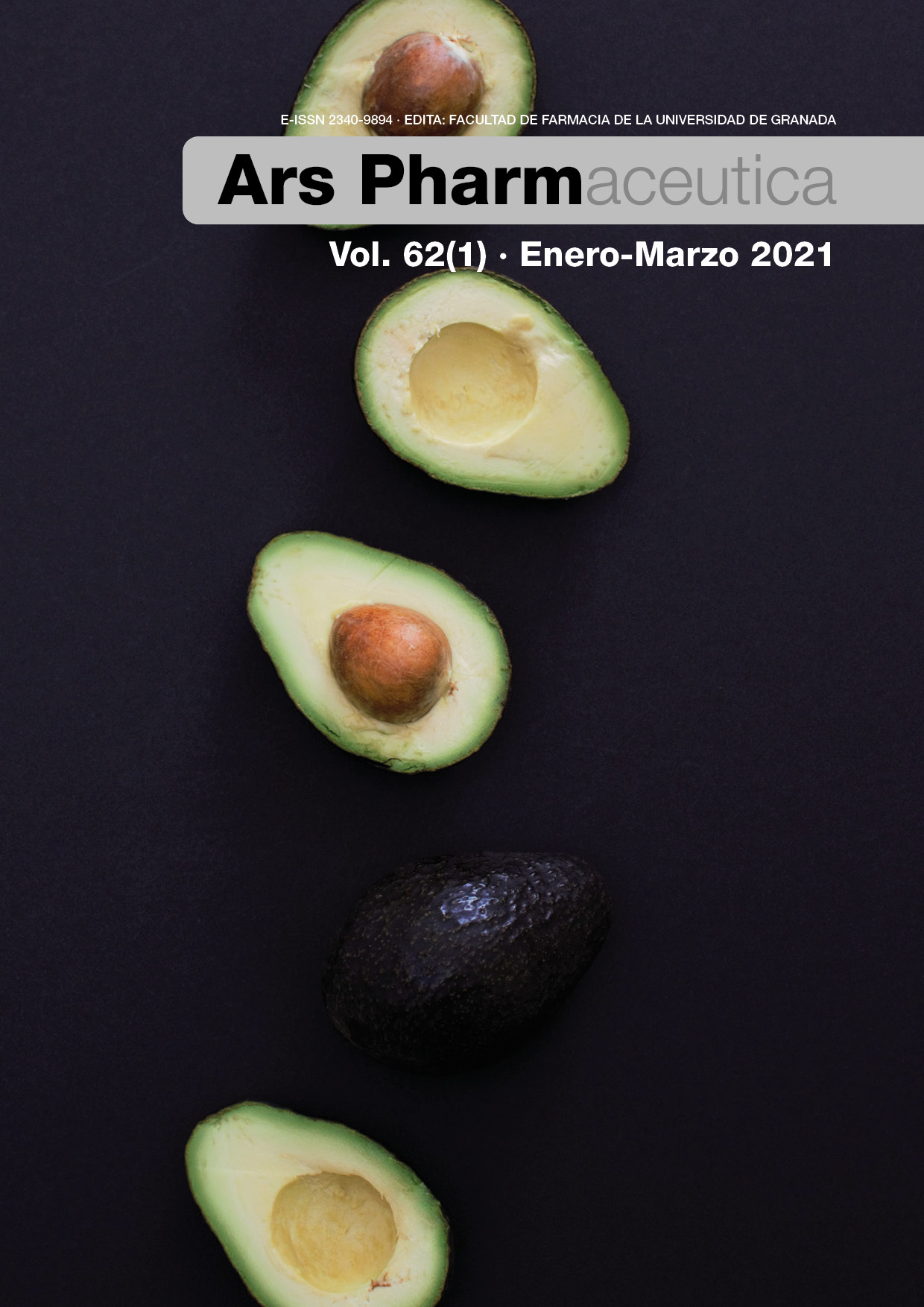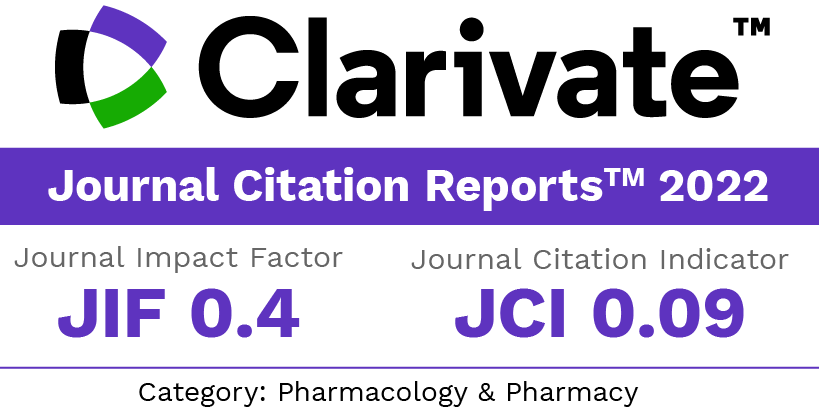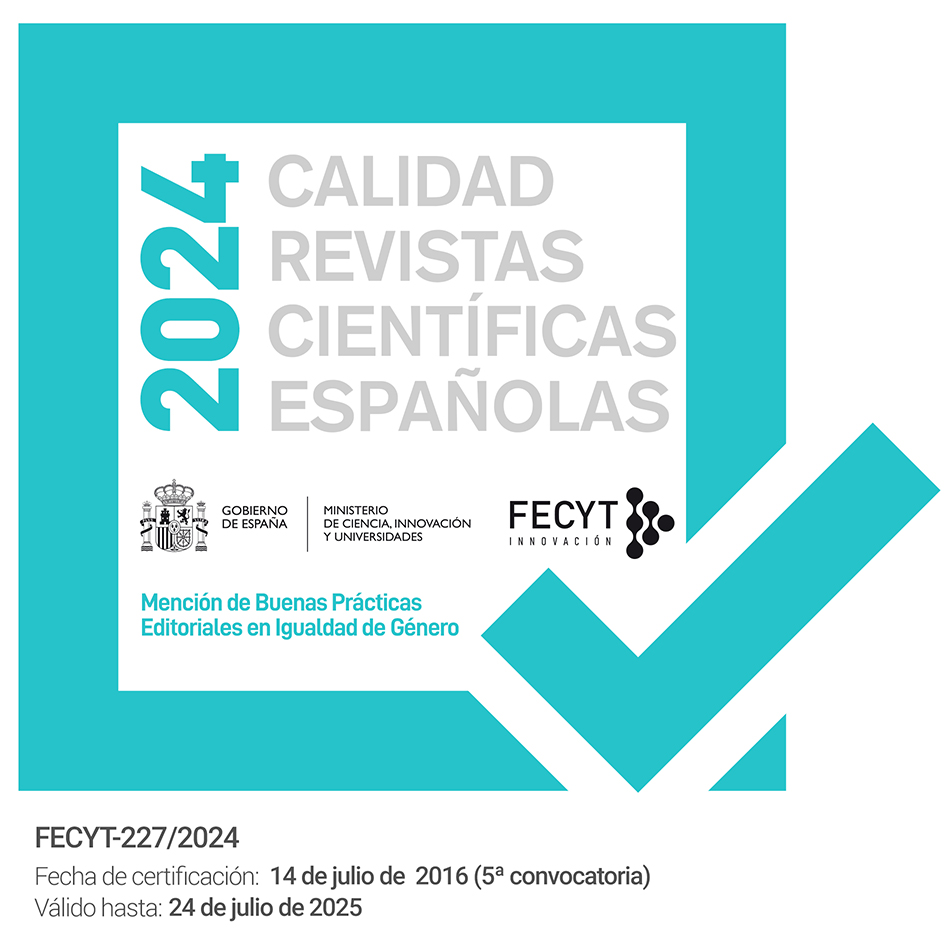Screening of avocado oil nanoformulations intended to skin delivery
Keywords:
drug delivery systems, nanoparticles, plant oil, avocadoAbstract
Introduction: vegetable ingredients are increasingly common in skin products. Avocado oil is an ingredient of natural source with various properties on skin. In this work crude avocado oil-loaded nanocapsules were evaluated regarding to its physicochemical stability to obtain a skin delivery formulation with adequate quality.
Method: nanoparticles formulations with components variation were evaluated for 2 months. Nanoparticle formulation considered the most stable was further evaluated for 6 months. Furthermore, oxidative stability of nanoencapsulated avocado oil and crude avocado oil was also performed in order to detect any sign of oil oxidation.
Results: all formulations had negative zeta potential after 2 months of storage. pH values of nanoparticles remained stable throughout the test. Formulation with the lowest content of ingredients exhibited the highest stability after 2 months of storage. Nanoencapsulated avocado oil and crude avocado oil showed no evidence of oxidation.
Conclusions: Aqueous dispersions with the lowest content of ingredients presented the best physicochemical stability. Therefore, we have demonstrated preliminary the feasibility of developing avocado-oil loaded nanocapsules.
Downloads
References
Woolf A, Wong M, Eyres L, et al. Avocado Oil. Robert A. Moreau, Kamal-Eldin A, editors. Gourmet and Health-Promoting Specialty Oils. Urbana: AOCS Press; 2009. 73–125 p. doi: 10.1016/B978-1-893997-97-4.50008-5.
Flores M, Saravia C, Vergara C, Avila F, Valdés H, Ortiz-Viedma J. Avocado Oil: Characteristics, Proper¬ties, and Applications. Molecules. 2019;24(11):2172–2193. doi:10.3390/molecules24112172.
de Oliveira AP, Franco EDS, Rodrigues Barreto R, et al. Effect of Semisolid Formulation of Persea Americana Mill (Avocado) Oil on Wound Healing in Rats. Evid Based Complement Alternat Med. 2013;2013:1–8. doi:http://dx.doi.org/10.1155/2013/472382.
Stücker M, Memmel U, Hoffmann M, Hartung J, Altmeyer P. Vitamin B12 Cream Containing Avocado Oil in the Therapy of Plaque Psoriasis. Dermatology. 2001;203(2):141–147. doi:10.1159/000051729.
Swischer H. Avocado oil from food use to skin care. J Am Oil Chem Soc. 1988;65(11):1704–1713. doi:10.1007/BF02542367. doi: 10.1007/BF02542367.
Berasategi I, Barriuso B, Ansorena D, Astiasarán I. Stability of avocado oil during heating: Compara¬tive study to olive oil. Food Chem. 2012;132(1):439–446. doi:10.1016/j.foodchem.2011.11.018.
Gilbert E, Roussel L, Serre C, et al. Percutaneous absorption of benzophenone-3 loaded lipid nanoparticles and polymeric nanocapsules: A comparative study. Int J Pharm. 2016;504(1–2):48–58. doi:10.1016/j.ijpharm.2016.03.018.
Hanno I, Anselmi C, Bouchemal K. Polyamide Nanocapsules and Nano-emulsions Containing Parsol® MCX and Parsol® 1789: In Vitro Release, Ex Vivo Skin Penetration and Photo-Stability Studies. Pharm Res. 2012;29(2):559–573. doi:10.1007/s11095-011-0592-5.
Tagliari MP, Granada A, Silva MAS, et al. Development of oral nifedipine-loaded polymeric nanocap¬ules: physicochemical, characterisation, photostability studies, In vitro and In vivo evaluation. Quim Nova. 2015;38(6):781–786. doi:10.5935/0100-4042.20150076.
Mora-Huertas CE, Fessi H, Elaissari A. Polymer-based nanocapsules for drug delivery. Int J Pharm. 2010;385(1–2):113–142. doi:10.1016/j.ijpharm.2009.10.018.
Zanotto-Filho A, Coradini K, Braganhol E, et al. Curcumin-loaded lipid-core nanocapsules as a strat¬egy to improve pharmacological efficacy of curcumin in glioma treatment. Eur J Pharm Biopharm. 2013;83(2):156–167. doi:10.1016/j.ejpb.2012.10.019.
Contri RV, Ribeiro KLF, Fiel LA, Pohlmann AR, Guterres SS. Vegetable oils as core of cationic polymer¬ic nanocapsules: influence on the physicochemical properties. J Exp Nanosci. 2013;8(7–8):913–924. doi:10.1080/17458080.2011.620019.
Badri W, Miladi K, Eddabra R, Fessi H, Elaissari A. Elaboration of Nanoparticles Containing Indo¬methacin: Argan Oil for Transdermal Local and Cosmetic Application. J Nanomater. 2015;2015:1–9. doi:10.1155/2015/935439.
Venturini CG, Bruinsmann F., Oliveira CP, Contri R V., Pohlmann AR, Guterres SS. Vegetable Oil-Load¬ed Nanocapsules: Innovative Alternative for Incorporating Drugs for Parenteral Administration. J Na¬nosci Nanotechnol. 2016;16(2):1310–1320. doi:10.1166/jnn.2016.11666.
Almeida JA, Jezur L, Fontana MC, et al. Oil-based nanoparticles containing alternative vegeta¬ble oils (grape seed oil and almond kernel oil): Preparation and characterization. Lat Am J Pharm. 2009;28(2):165–172.
Contri RV., Kulkamp-Guerreiro IC, da Silva SJ, Frank LA, Pohlmann AR, Guterres SS. Nanoencapsu¬lation of Rose-Hip Oil Prevents Oil Oxidation and Allows Obtainment of Gel and Film Topical Formula¬tions. AAPS PharmSciTech. 2016;17(4):863–871. doi:10.1208/s12249-015-0379-9.
da Silva ALM, Contri RV, Jornada DS, Pohlmann AR, Guterres SS. Vitamin K1-loaded lipid-core nanocapsules: physicochemical characterization and in vitro skin permeation. Ski Res Technol. 2013;19(1):e223–e230. doi:10.1111/j.1600-0846.2012.00631.x.
AOCS. Official and Recomended practices of AOCS. 7th ed. Champaign: AOCS Press; 2017. 3000 p.
Jorge T de S, Polachini TC, Dias LS, Jorge N, Telis-Romero J. Physicochemical and rheological characterization of avocado oils. Ciência e Agrotecnologia. 2015;39(4):390–400. doi:10.1590/S1413-70542015000400010.
Jäger E, Venturini CG, Poletto FS, et al. Sustained release from lipid-core nanocapsules by vary¬ing the core viscosity and the particle surface area. J Biomed Nanotechnol. 2009;5(1):130–140. doi: 10.1166/jbn.2009.1004.
Lobato KB de S, Paese K, Forgearini JC, Guterres SS, Jablonski A, Rios A de O. Characterisation and stability evaluation of bixin nanocapsules. Food Chem. 2013;141(4):3906–3912. doi:10.1016/j.food-chem.2013.04.135.
Patravale VB, Date AA, Kulkarni RM. Nanosuspensions: a promising drug delivery strategy. J Pharm Pharmacol. 2004;56(7):827–840. doi:10.1211/0022357023691.
Schaffazick SR, Guterres SS, Freitas L de L, Pohlmann AR. Caracterização e estabilidade físi¬co-química de sistemas poliméricos nanoparticulados para administração de fármacos. Quim Nova. 2003;26(5):726–737. doi:10.1590/S0100-40422003000500017.
Venturini CG, Jäger E, Oliveira CP, et al. Formulation of lipid core nanocapsules. Colloids Surfaces A Physicochem Eng Asp. 2011;375(1–3):200–208. doi:10.1016/j.colsurfa.2010.12.011.
de Zampieri ALTC, Ferreira FS, Resende ÉC, et al. Biodegradable Polymeric Nanocapsules Based on Poly(DL-lactide) for Genistein Topical Delivery: Obtention, Characterization and Skin Permeation Studies. J Biomed Nanotechnol. 2013;9(3):527–534. doi:10.1166/jbn.2013.1555.
Werman MJ, Neeman I. Oxidative stability of avocado oil. J Am Oil Chem Soc. 1986;63(3):355–360. doi:10.1007/BF02546046.
Downloads
Published
How to Cite
Issue
Section
License
Copyright (c) 2020 Júlia Scherer Santos, Júlia Cristina Koppe de Conto, Chana Medeiros da Silva, Rosana de Cassia de Souza Scheneider, Claudia Regina Müller

This work is licensed under a Creative Commons Attribution-NonCommercial-ShareAlike 4.0 International License.
The articles, which are published in this journal, are subject to the following terms in relation to the rights of patrimonial or exploitation:
- The authors will keep their copyright and guarantee to the journal the right of first publication of their work, which will be distributed with a Creative Commons BY-NC-SA 4.0 license that allows third parties to reuse the work whenever its author, quote the original source and do not make commercial use of it.
b. The authors may adopt other non-exclusive licensing agreements for the distribution of the published version of the work (e.g., deposit it in an institutional telematic file or publish it in a monographic volume) provided that the original source of its publication is indicated.
c. Authors are allowed and advised to disseminate their work through the Internet (e.g. in institutional repositories or on their website) before and during the submission process, which can produce interesting exchanges and increase citations of the published work. (See The effect of open access).



















